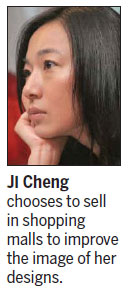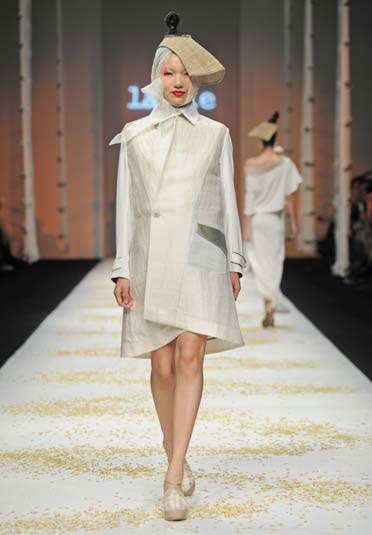Red, white and no blues
Updated: 2013-02-01 08:56
By Yao Jing (China Daily)
|
||||||||
|
One of Ji's designs from her 2013 spring and summer collection. Provided to China Daily |

Fashion designer has outgrown shanghai's changle road, ready to reach for the top in haute couture
Fashion designer Ji Cheng has won international acclaim with her Chinese-themed creations and signature red-and-white designs, and she is intent on keeping her success homegrown.
It was only a few months ago that Teasome, her ready-to-wear collection for 2013 spring and summer, was turning heads at London Fashion Week. The show, with designs inspired by 1,200-year-old "Tea Bible" (Lu Yu's Cha Ching), followed one she presented at the city's other biannual fashion week in February.
"London Fashion Week is a springboard for emerging designers, and I think it is time for my brand to appear on a bigger stage as it has been in the market for 10 years," Ji says.
After the shows, Ji signed a contract with the London-based AMF showroom, whose sales agents will help promote her label, and consult on design and material choice to better cater to the international market.
At the same time, she closed her small store in Changle Road, Shanghai, aiming to sell through shopping malls rather than scattered boutiques. "We have been thinking about how to position the brand, and then decided that the trendy high-street style of Changle Road no longer fitted its image."
She had outgrown the little nest and was spreading her wings - but not too wide and high, fearing an Icarus-like outcome.
While designers around the world battle for the attention of increasing numbers of Chinese consumers, Ji Cheng is wary about rushing into expanding her business outside her homeland. Rather, she hopes to develop an international brand by exposing the rest of the world to the popular aesthetic of contemporary China.
"We are not planning something big, but aiming to keep stable and keep studying."
Ji established her La Vie luxury designer brand when she returned to Shanghai in 2002, after studying at the Instituto Marangoni in Milan and working at Basic Krizia, Missoni Sport and D'A as a designer and visual director.
As with the Teasome collection, her clothes are recognizable for applying symbolic Chinese characteristics using a Western style of cutting in design. Blue tiger porcelain, 1930s-style Shanghai calendar girls, peacock patterns and other traditional Chinese images have inspired her lines. But she says she is not interested in copying tight-fitting qipao dresses. She wants modernity and variety without stereotyping.
A shirt or dress from her ready-to-wear line costs about 4,000 yuan ($642; 476 euros), while a made-to-measure wedding dress or evening dress from her Wedding collection can cost hundreds of thousands.
"We are targeting independent women between 25 and 45 years old who are looking for something special and appreciate freedom in style," Ji says.
Ji operates three retail stores in Shanghai. Among the upmarket outlets of Huaihai Road's shopping strand, one store houses the Wedding line showroom, her studio and workshop.
The fashion house's turnover is growing 35 percent each year, Ji says. For La Vie, she introduces about 80 styles of clothes each season, and sells about 45 percent of her total production.
"Although I am looking for more consumers, I do not want my clothes to become common, but to keep the unique style."
Location is becoming more important for a designer, she believes. Footfall in shopping mall is more steady and consumers tend to be more selective. Ji is approaching shopping malls in China, hoping to open more stores, and her sales agent is promoting her products to department stores in Europe.
yaojing@chinadaily.com.cn
(China Daily 02/01/2013 page12)

 Li Na on Time cover, makes influential 100 list
Li Na on Time cover, makes influential 100 list
 FBI releases photos of 2 Boston bombings suspects
FBI releases photos of 2 Boston bombings suspects
 World's wackiest hairstyles
World's wackiest hairstyles
 Sandstorms strike Northwest China
Sandstorms strike Northwest China
 Never-seen photos of Madonna on display
Never-seen photos of Madonna on display
 H7N9 outbreak linked to waterfowl migration
H7N9 outbreak linked to waterfowl migration
 Dozens feared dead in Texas plant blast
Dozens feared dead in Texas plant blast
 Venezuelan court rules out manual votes counting
Venezuelan court rules out manual votes counting
Most Viewed
Editor's Picks

|

|

|

|

|

|
Today's Top News
Boston bombing suspect reported cornered on boat
7.0-magnitude quake hits Sichuan
Cross-talk artist helps to spread the word
'Green' awareness levels drop in Beijing
Palace Museum spruces up
First couple on Time's list of most influential
H7N9 flu transmission studied
Trading channels 'need to broaden'
US Weekly

|

|








